Introduction #
Terraforming Mars isn’t just a board game–it’s a voyage of ambition, innovation, and interplanetary enterprise that sweeps you into the exhilarating challenge of reshaping an entire planet. Through its immersive, high-stakes gameplay, the game instantly pulls you into its narrative of corporate conquest on the Red Planet. The allure of building a new home for humanity is irresistible. Every decision matters and every move advances the monumental goal of terraforming Mars. With its intricate blend of economic strategy, area control, and thematic depth, Terraforming Mars is a towering achievement in modern board gaming. Prepare yourself for an epic journey as we break down this all-time favorite, a game that has redefined what it means to reshape worlds–one generation at a time.
Overview #
In Terraforming Mars, you step into the role of a powerful corporation tasked with transforming the barren Martian landscape into a thriving, habitable world. At its core, the game revolves around resource management and strategic decision-making across multiple generations. Each turn is structured into distinct phases that mirror the passage of time and the gradual, monumental changes occurring on Mars.
During a generation, you first jump into the Research phase where you draw and purchase project cards representing new technologies and infrastructure, offering you fresh opportunities to advance your terraforming agenda.
Next comes the Action phase–a dynamic sequence where you play cards, activate special actions, or invest in projects that raise Mars’ temperature, oxygen levels, or ocean coverage. Every decision is a balance between long-term strategy and immediate tactical advantage, as you vie not only to terraform the planet but also to outmaneuver your rivals.
Finally, the Production phase is where the tangible results of your investments come to life. Here, resources are generated based on your current achievements and improvements, setting you up for the challenges of the next generation. This cyclical process continues until the critical global parameters–temperature, oxygen, and ocean–reach their set goals, culminating in the final scoring that determines the ultimate victor.
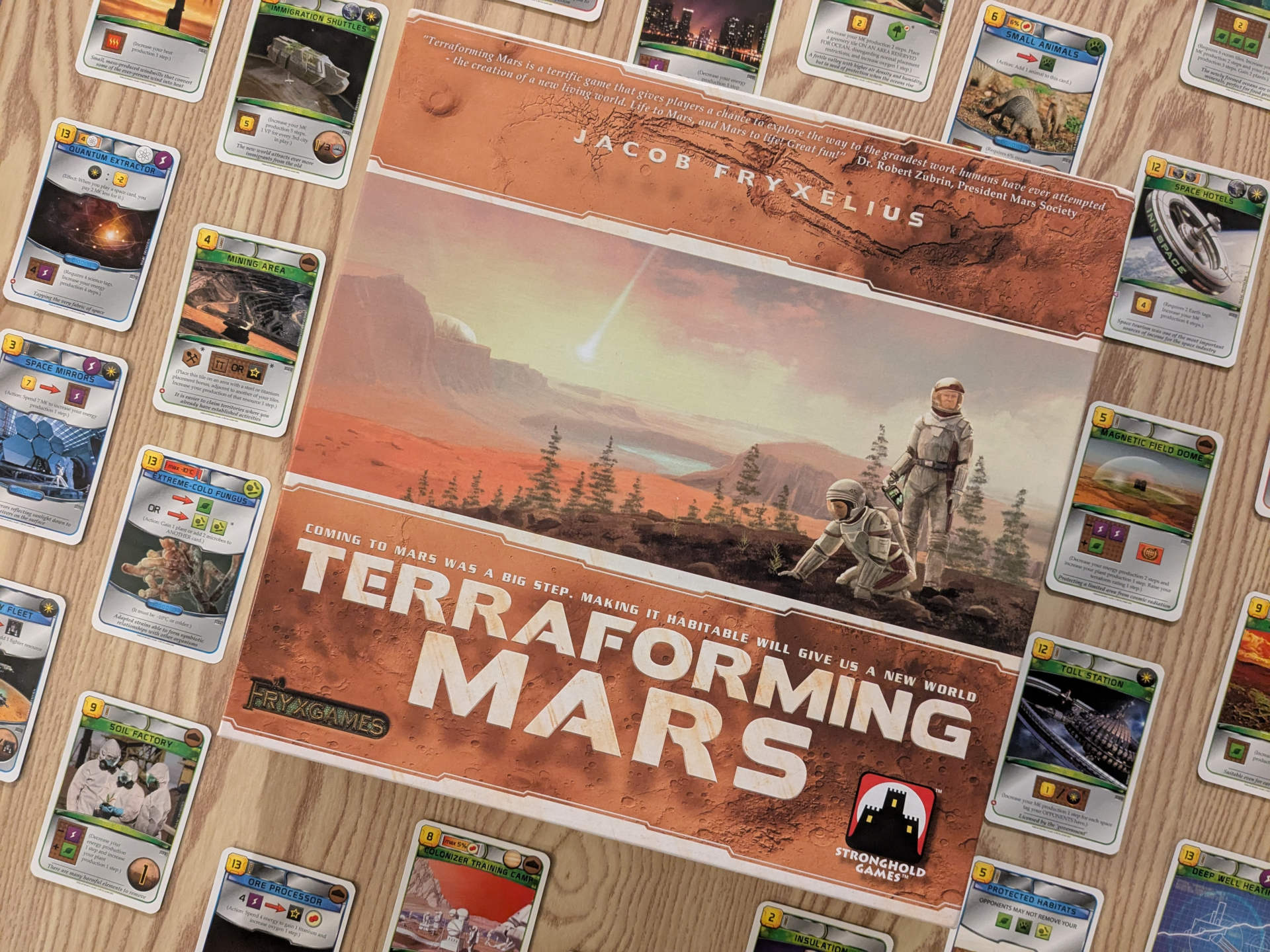
From initiating cutting-edge research to building crucial infrastructure, the game captures the essence of scientific progress and corporate strategy. The seamless blend of theme and mechanics makes Terraforming Mars a compelling journey of transformation on both a planetary and a personal scale. Every turn is packed with decisions that echo the grand narrative of reshaping an entire planet.
Gameplay #
Playing Terraforming Mars is like being the CEO of a futuristic megacorporation where every decision resonates on multiple levels. The gameplay thrives on the freedom to specialize. In many Eurogames, specialization is often risky or underpowered; here, it’s celebrated. Whether you’re focusing on building a robust energy engine, a powerhouse mining operation, or a cutting-edge ecological research hub, every path is viable. This flexibility is further enriched by the variable powers of the different corporations. Each corporation feels distinct and it’s like having your own set of trade secrets or specialized technological edge.
At its heart, the game is a race–a race against both time and your competitors. You’ll find yourself managing three terraforming global parameters while also contending with milestones, awards, and a thrilling area control battle over the Martian map. The multitude of races going on–whether it’s the race to raise the oxygen level, increase temperature, or place critical tiles–can seem overwhelming at first. But this complexity is precisely what makes the game so replayable and engaging. Each turn brings new opportunities to outmaneuver your opponents and capitalize on fleeting strategic windows. Every card drawn, every project undertaken, feels exciting and consequential.
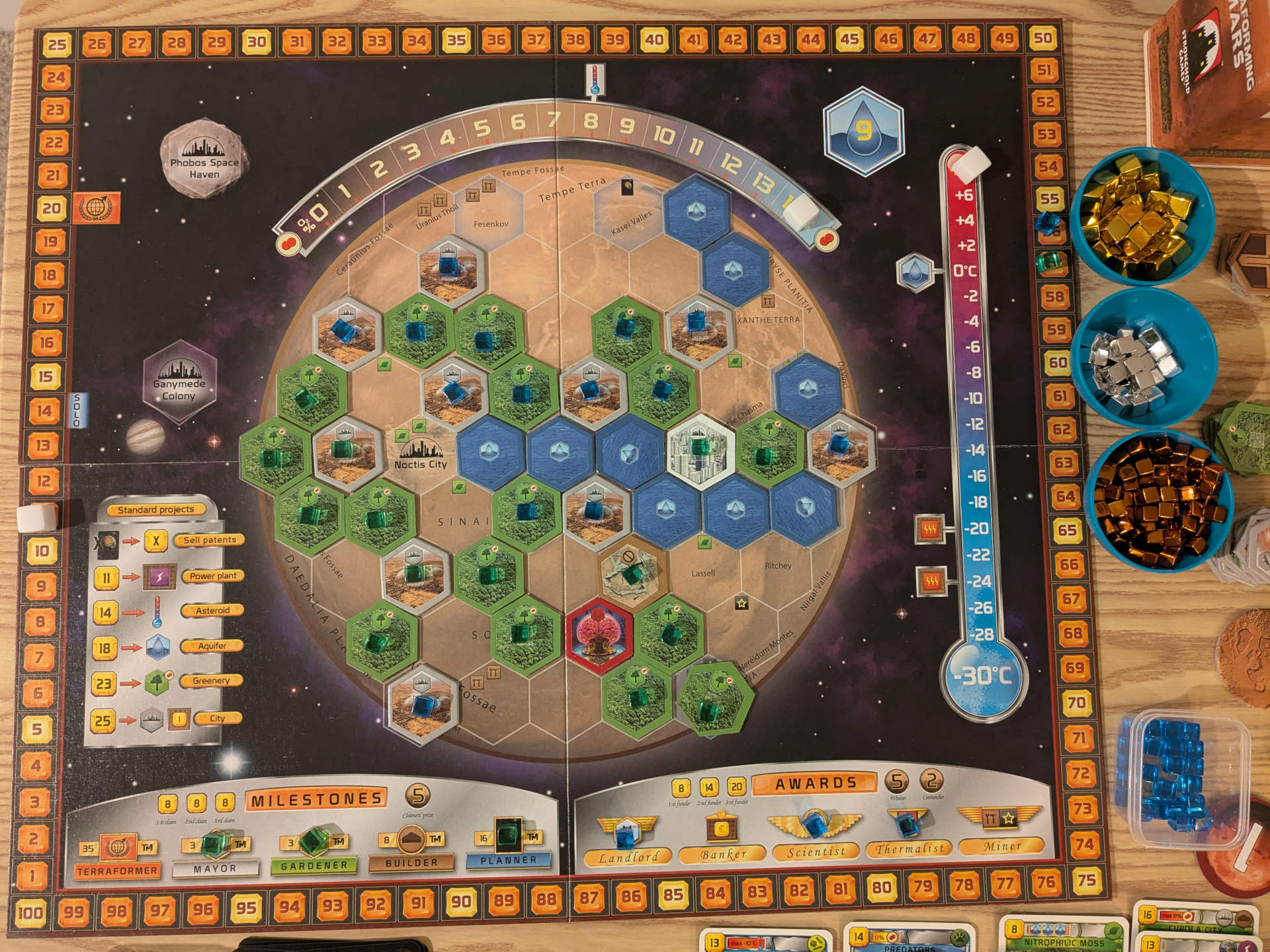
The intricate dance between long-term planning and immediate tactical decisions is what truly makes Terraforming Mars shine. One moment, you’re investing in an engine that will pay off in later generations; the next, you’re scrambling to capitalize on a global parameter bonus or to beat a rival for a critical milestone. The game builds momentum as engines fire up, rewarding players with a deeply satisfying sense of progress.
The balance between cooperative and competitive elements is handled masterfully. While every player is racing towards the shared goal of terraforming Mars, the struggle for individual supremacy adds a tantalizing layer of tension and excitement. The dynamic interplay of resource management, area control, and strategic card play creates a game environment where no two sessions are alike, ensuring that the journey to a habitable Mars is as unpredictable as it is thrilling.
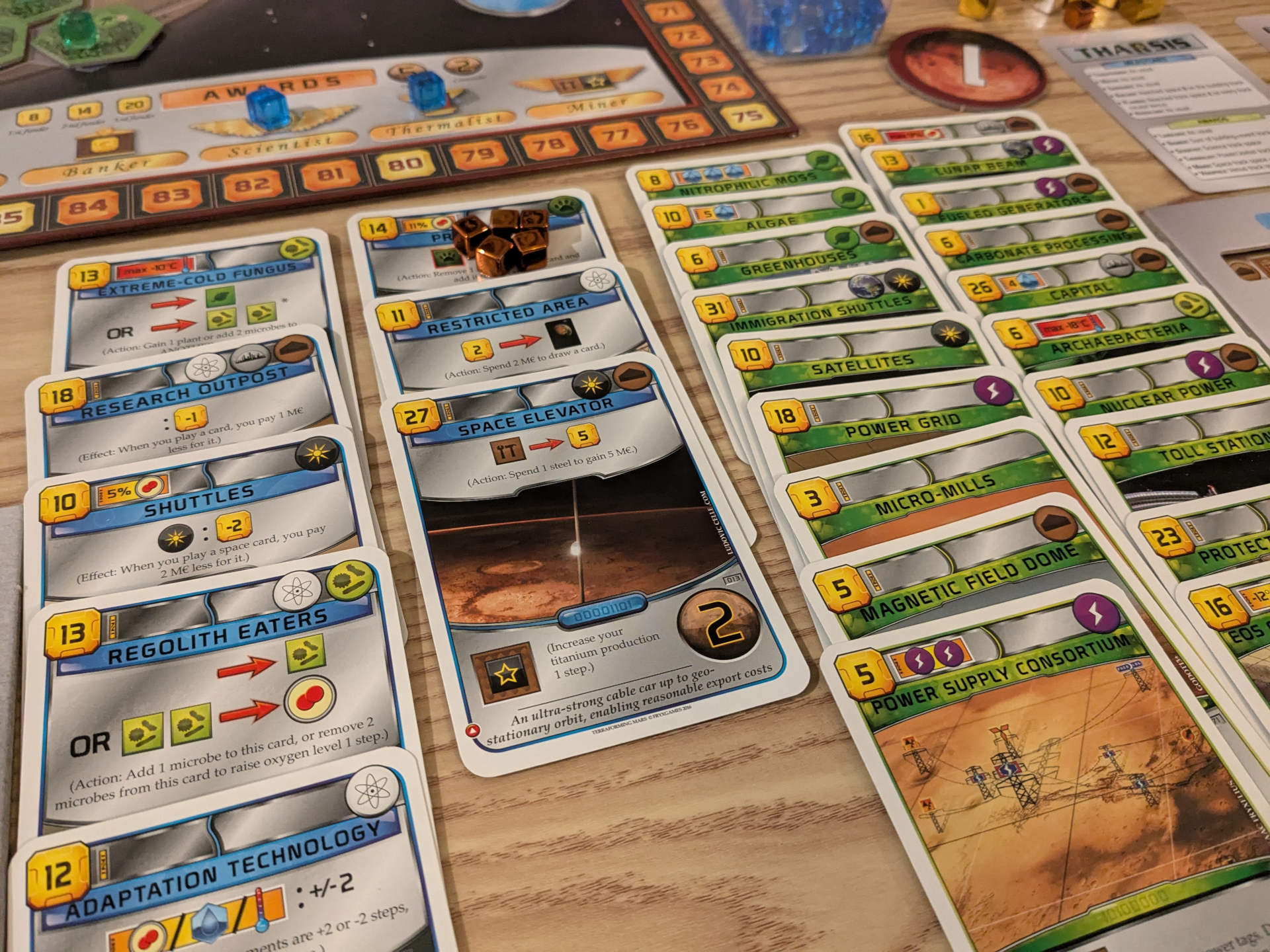
However, the game isn’t without its challenges. One of the more daunting aspects is the sheer volume of cards available. With hundreds of options at your fingertips, choosing the right card at the right time can sometimes feel overwhelming. The multitude of strategic possibilities, while adding to the game’s replayability and depth, can occasionally slow down decision-making and make the game drag on in larger groups. This slowdown, however, is largely absent in solo play, where the focus is solely on your own empire-building journey.
Despite these minor critiques, the overall flow of Terraforming Mars is electrifying. Each generation is a microcosm of the grand race for Mars: you plan, execute, and then watch as your strategic investments bear fruit during the Production phase. Every action you take–from playing a card that sparks a technological breakthrough to placing a tile that edges you closer to controlling key areas of the board–is a critical step in your quest to reshape the planet.
Solo Play #
For those brave enough to take on the Martian challenge alone following the base game solo rules, it means wrestling with the game’s full endeavor on your own–a true test of strategic ingenuity. This solo mode forces you to manage every aspect of terraforming without the option to specialize. If you successfully terraform within 14 generations you win, fail and you lose. The end-game scoring is secondary here and many times the cards aimed at boosting final scores just get in the way of your primary goal–terraforming. The first generations feel punishingly slow for this solo endeavor and more often than not, just when your engine starts to get into full swing, the game reaches its conclusion, leaving you with a bittersweet sense of “what could have been.” Additionally, the absence of milestones and awards makes the solo experience feel incomplete compared to group play.
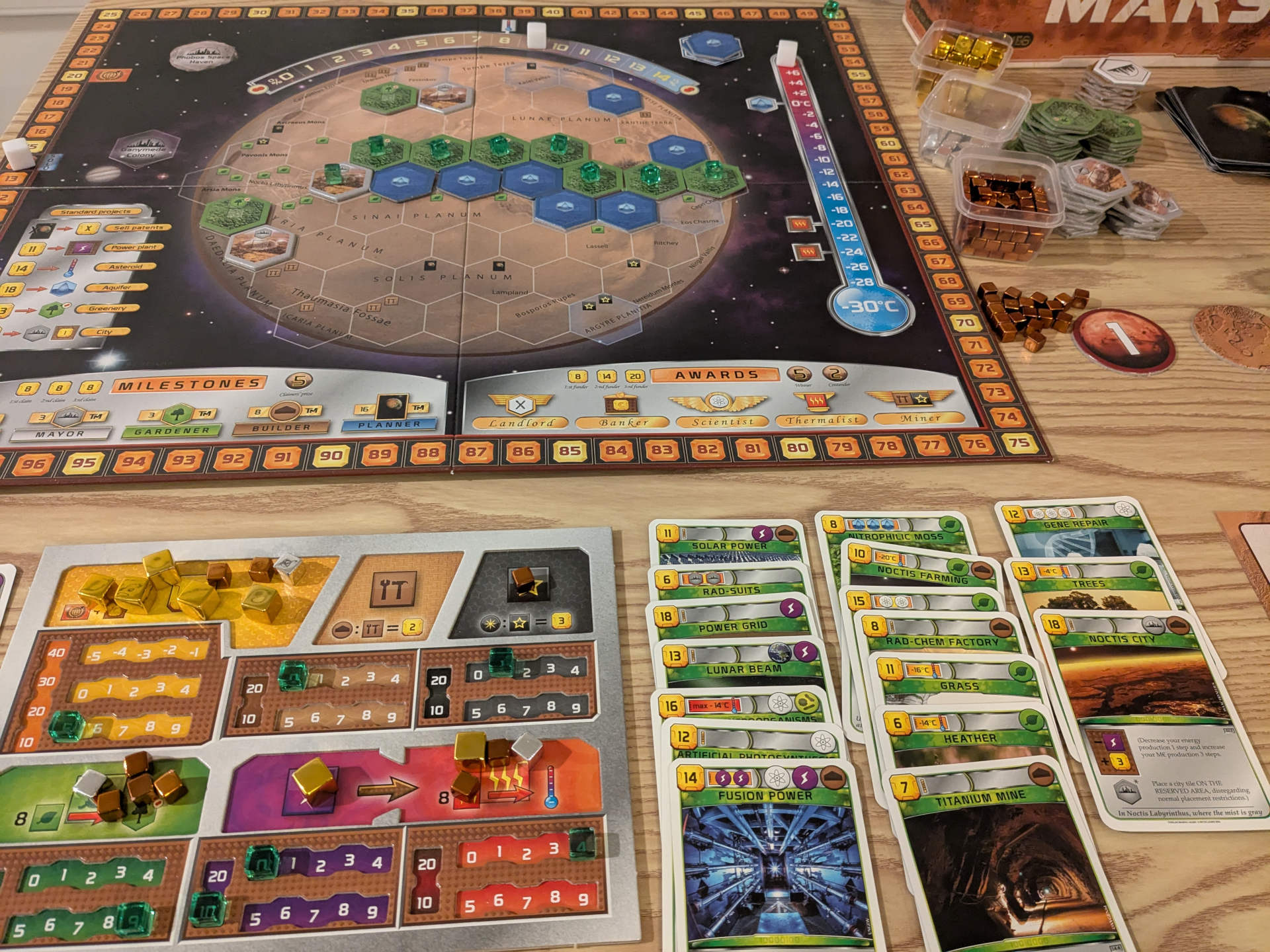
As of 2024, FryxGames has introduced the Terraforming Mars: Automa expansion which has breathed new life into what was a barren solo experience for me. My solo rating for this game is now based on the experience with the Automa expansion. This expansion restores the coopetition aspect of group play by giving you a smart, full-featured AI opponent, MarsBot, that can compete against even the best human corporations in terraforming Mars. Best of all, the AI can adapt to any mix of expansions. I found the automa reasonable to operate and it allows players to enjoy the full experience of Terraforming Mars with every mechanic and feature available in group play including the milestones and awards. You can read the full details in my review of the Terraforming Mars: Automa expansion.
Components and Design #
The thematic cohesion in Terraforming Mars is nothing short of inspiring. The game board, with its meticulously designed map inspired by the actual topography of Mars, is a masterpiece of thematic design. The incorporation of real Martian features–volcanoes, canyons, and low-lying ocean areas–creates an immersive environment that draws you into the narrative of planetary transformation. It’s a wonderful marriage of mechanics and theme that elevates the gameplay experience.
The flavor text and the names of the various corporations create a unique sense of immersion. I identify differently with each corporation imagining how each corporation’s trade secrets, technology, and vision change how they approach the mission. Similarly, every project card feels like a small piece of a grand narrative, giving you the sensation of commanding a real interstellar enterprise. This narrative depth is further enhanced by the clever measurement of rounds as human generations, a design choice that really makes you contemplate the magnitude of the endeavor at hand. It’s not just about winning a game–it’s about leading humanity into a new era, one generation at a time. I also find myself drawing thematic parallels to the video game, Offworld Trading Company, which was also a cherished experience for me. The two games have created a special place in my heart for this rare theme of corporate competition and sci-fi.
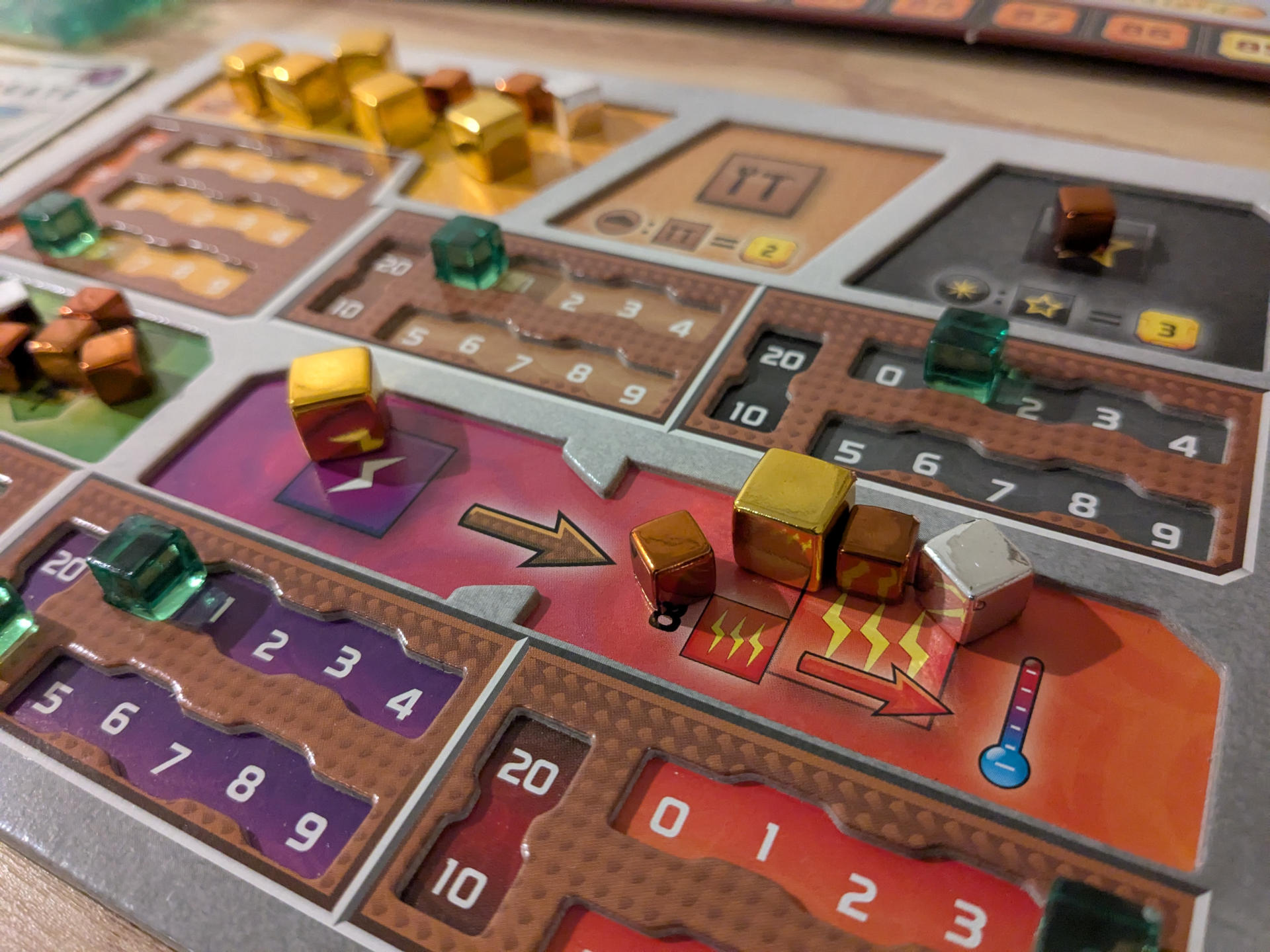
The artwork and component quality, while not luxurious, effectively complement the game’s theme. From a components standpoint, Terraforming Mars follows the standard offering for a Eurogame though the metallic-painted cubes almost feel like a delux-ification for its time. On the other hand, the project cards are on the thinner side and feel flimsy, but this is nothing compared to the most common gripe about Terraforming Mars’ components–the player boards. With single-layered resource tracks and pools, the player boards have become the recurring villain in anecdotes about game nights ruined by one bump of the table. Seeking out upgraded player boards makes all the difference here and they are still one of my most treasured and thoughtful gifts from a friend.
Final Thoughts #
Terraforming Mars is an absolute triumph of design and gameplay, a game that encapsulates the wonder of space exploration and the thrill of corporate strategy. Its nuanced mechanics, deep strategic layers, and thematic richness come together to create an experience that is as engaging as it is challenging. Every decision, every generation, and every challenge faced on Mars is a testament to the game’s intricate design and enduring appeal. It’s this blend of complexity and thematic grandeur that keeps players coming back generation after generation, eager to leave their mark on the Red Planet.
For solo players, the Terraforming Mars: Automa expansion is an essential addition that allows this game to shine in solitary play just as it has for years in group play. Perhaps even outshining group play at high player counts.
Overall, Terraforming Mars is a game I never tire of revisiting. If you haven’t yet embarked on this interstellar journey, now is the perfect time to join the ranks of visionary CEOs shaping the future of humanity.
We purchased this product independently. All opinions expressed are independent, honest, and unbiased.
- Rich corporate sci-fi premise that immerses players in the process of transforming Mars
- Compelling blend of long-term planning and immediate tactical decisions
- Multiple viable paths and variable corporation abilities contribute to a fresh and highly replayable experience.
- The Automa expansion makes solitary play as engaging and fulfilling as group sessions.
- The sheer volume of cards and strategic options can be overwhelming, sometimes slowing down decision-making in larger groups.
- A single table bump can make a mess of your resource tracks on the single-layered player boards.
- The solo version in the base game is underwhelming and feels like a different game.
Learn more about how we rate board games...
